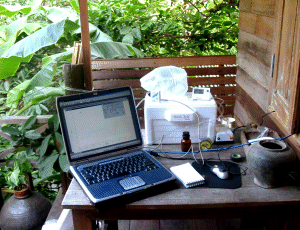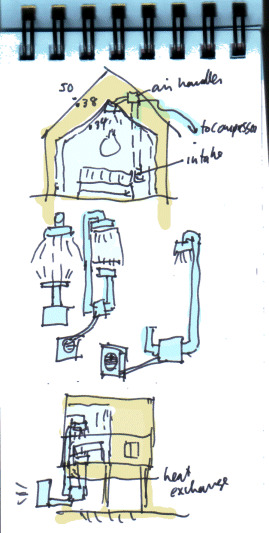Note for new readers: this blog presents a rather technical approach to the subject of living comfortably in the tropics. It aims to teach you about tropical comfort and discomfort. Don't read this blog unless you got a "B" or better in high school physics or are an architect/builder who needs to understand heat transfer! If you're more interested in tropical lifestyle matters, the ups and downs of living in paradise, you can check out the blog by my brother Jack at:
http://www.nationmultimedia.com/webblog/home.php?uid=361
One of our readers, reflecting on the pleasures of keeping cool using one of those "mist fan" machines while struggling to enjoy a good cigar, raises the following question:
There has to be some balance point here, where body cooling by external evaporation is such that the body does not need to sweat heavily and so is happy in a high humidity atmosphere. These machines do work, the only problem I have with them is keeping my cigar alight...........
Yao Bar at sundown, your author making the sketch that you see here
 Appropriate meditiation on this matter requires a proper setting, and I write here from one of my favorite streetside venues, the Yao Bar off Ekamai, where the sun is setting in a tawny sky at the end of a day warm enough to raise a slight sweat as I was walking here. Now the waitress is serving a large (22 oz) bottle of cold Chang beer, 70 baht, over a large glass of ice cubes (3 degrees C, but my radiant thermometer is probably mistaken here because it's mosquito brain does not really know the exact emssivivity of ice, or as you can see, of the sky which of course is not 6 degrees but closer to 30 degrees, only emitting like a 6 degree object). Here, carressed by a gentle breeze, watching life, much of it casually and lightly clothed as tends to be on these sois, I am comfortable enough, not sweating at all, though I am continuing to produce, as we all do while engaged in these indolent activities -- and subsisting on a healthy Thai diet of fish and rice, not fatty British pub food simultaneously engaged in heated discusion of such matters as cricket and motor racing-- heat. And my heat production is likely to be around 50 watts.
Appropriate meditiation on this matter requires a proper setting, and I write here from one of my favorite streetside venues, the Yao Bar off Ekamai, where the sun is setting in a tawny sky at the end of a day warm enough to raise a slight sweat as I was walking here. Now the waitress is serving a large (22 oz) bottle of cold Chang beer, 70 baht, over a large glass of ice cubes (3 degrees C, but my radiant thermometer is probably mistaken here because it's mosquito brain does not really know the exact emssivivity of ice, or as you can see, of the sky which of course is not 6 degrees but closer to 30 degrees, only emitting like a 6 degree object). Here, carressed by a gentle breeze, watching life, much of it casually and lightly clothed as tends to be on these sois, I am comfortable enough, not sweating at all, though I am continuing to produce, as we all do while engaged in these indolent activities -- and subsisting on a healthy Thai diet of fish and rice, not fatty British pub food simultaneously engaged in heated discusion of such matters as cricket and motor racing-- heat. And my heat production is likely to be around 50 watts.
Now sitting here I perceive that I am comfortable but on the verge of sweating. (At this point I can only appeal to the reader's intuition when I say comfortable, since I can neither define that term or conversely define its opposite, uncomfortable, though in the future we will necessarily have to face this definitional task, not as simple as it might first appear).
Let us now proceed to make some estimates of the transfer of heat that is occurring at my bodily envelope (having disposed of the problem of dealing with transfer of moisture, since I'm not sweating, though almost sweating).
Since I am warmer than the air around me by about 3 degrees, and the transfer of heat being a linear function of temperature difference with a constant of proportionality of about 10 (for a pleasant breeze) my transfer via convection to the air will be in watts
W=10*(34-31)=30 watts
I am also radiating heat directly to both the "cold" sky at 6 degrees and my other surroundings, and without going through l the tiresome arithmetic, Stefan Boltzmann constants and so forth (unless I later add an appendix to this chapter), my estimate for radiant loss is a minor 10-15 watts.
The 22 ounce bottle of Chang beer which by ingesting I am raising from 18 to 37 degrees over a time period of 20 minutes provides further cooling of about 5 watts, not counting the vasodilative impact of alcohol on improving the blood supply to my nose. I neglect my cigar, and I am now too weary with these exertions to account for respiratory loss, either sensible or latent, though I think it might be as much as a few watts.
Observation of surroundings: the waitress is hacking at a mango in the course of making herself som tam dinner; though lightly dressed her skinny brown legs to which my eyes are drawn are doubtless more effective in transferring heat to the air than my ham-like euro limbs. The bartender, who has a large belly, is engaged in mild activities, and has elected for his comfort to be shirtless. Altogether, we represent a sample of three varied non-sweating bodies, with heat production approximately equal to the rate of heat being lost to our environment. Therefore we meet a working definition of comfort with sweating:
Energy produced sweatlessly=energy lost without need for sweat.
On this basis, I propose that for a typical fahlang, sweating will not be necessary for sedentary activity with surrounding temperature (e.g. air temperature but also consider surrounding radiant temperatures) of about 30 degrees or a little less. Under these or cooler conditions, we do not call on any heat dissipative mechanism that is sensitive to humidity, so we may say in a gross sense that humidity is not a factor in our comfort. If however our level of effort should increase to say 100 watts, we will not be able to throw off enough heat to the surroundings and after a few minutes our body and skin temperature will begin to rise and our sweat system will activate, with the rate of cooling being very sensitive to humidity (more on this later). And we will begin to say that we are too warm (suggesting that sweat = thermal discomfort.)
So my answer is this: humidity doesn't matter too much (except in relation to such issues as keeping cigars lit and beers cool) as long as we are not sweating, ie at a temprature of roughly 30 degrees in sedentary mode.








































 too warm for sleeping. And if in your desperation to keep cool in the daytime you had installed some bulk insulation instead of the foil insulation, the "R" value might be double, and the required temperature to push 3 watts out through the roof even more, maybe 5 degrees, an even worse situation! Meanwhile the poor farmer next door will be happily snoozing with his tin roof at or below outside air temperature! His red line will closely track the blue line, maybe be even lower.
too warm for sleeping. And if in your desperation to keep cool in the daytime you had installed some bulk insulation instead of the foil insulation, the "R" value might be double, and the required temperature to push 3 watts out through the roof even more, maybe 5 degrees, an even worse situation! Meanwhile the poor farmer next door will be happily snoozing with his tin roof at or below outside air temperature! His red line will closely track the blue line, maybe be even lower.
